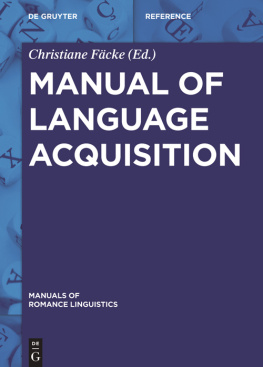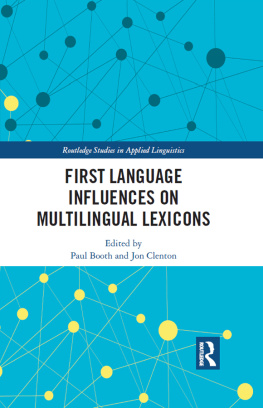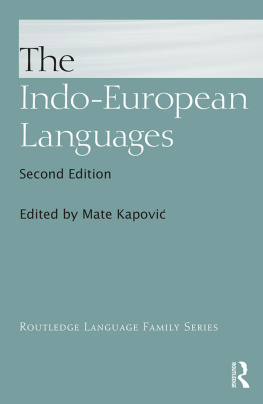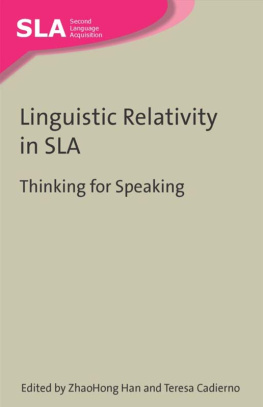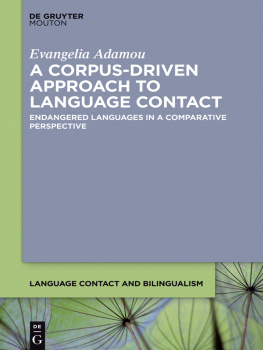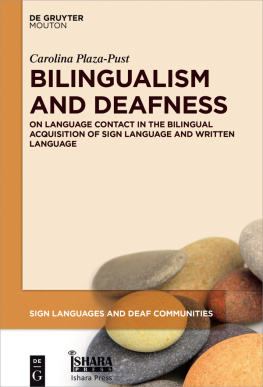Contents
Guide
Pagebreaks of the print version
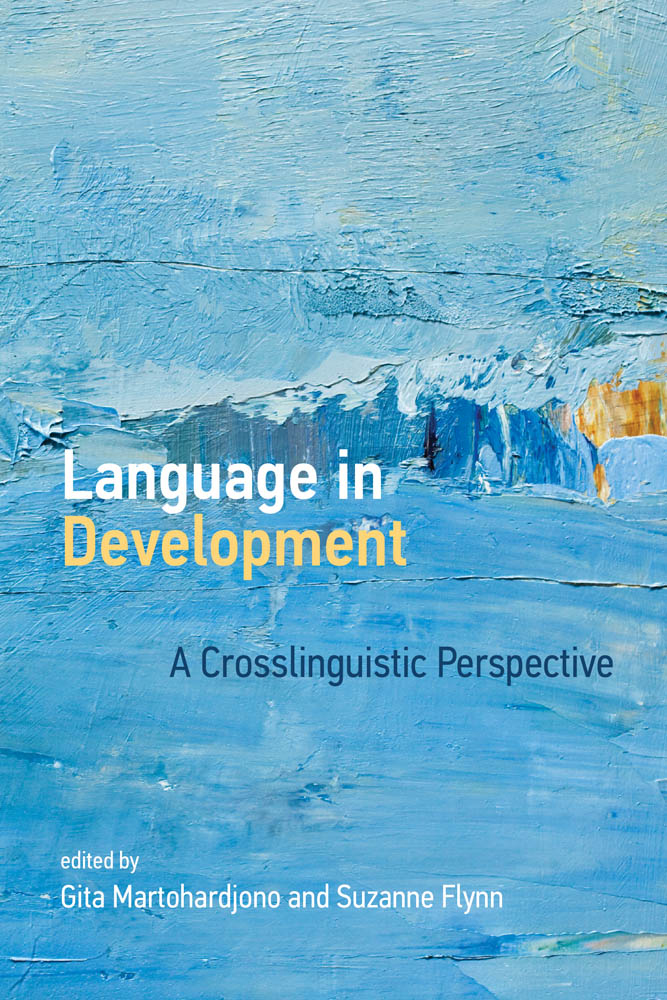
Language in Development
A Crosslinguistic Perspective
Edited by Gita Martohardjono and Suzanne Flynn
The MIT Press
Cambridge, Massachusetts
London, England
2021 The Massachusetts Institute of Technology
All rights reserved. No part of this book may be reproduced in any form by any electronic or mechanical means (including photocopying, recording, or information storage and retrieval) without permission in writing from the publisher.
The MIT Press would like to thank the anonymous peer reviewers who provided comments on drafts of this book. The generous work of academic experts is essential for establishing the authority and quality of our publications. We acknowledge with gratitude the contributions of these otherwise uncredited readers.
Library of Congress Cataloging-in-Publication Data
Names: Martohardjono, Gita, 1956- editor. | Flynn, Suzanne, editor.
Title: Language in development : a crosslinguistic perspective / edited by Gita Martohardjono and Suzanne Flynn.
Description: Cambridge, Massachusetts : The MIT Press, [2021] | Includes bibliographical references and index.
Identifiers: LCCN 2020044374 | ISBN 9780262542005 (paperback)
Subjects: LCSH: Language acquisition. | Similarity (Language learning) | Multilingualism.
Classification: LCC P118 .L36367 2021 | DDC 401/.93--dc23
LC record available at https://lccn.loc.gov/2020044374
d_r0
Contents
- Gita Martohardjono and Suzanne Flynn
- Virginia Valian
- D. Terence Langendoen
- Lila R. Gleitman, Kimberly Cassidy, Rebecca Nappa, Anna Papafragou, and John C. Trueswell
- Cristina Dye and Claire Foley
- Jennifer Austin, Liliana Snchez, Silvia Perez-Cortes, and David Giancaspro
- Yarden Kedar
- Mara Blume
- Reiko Mazuka
- Lynn M. Santelmann
- Yun Yao and Jerome Packard
- Gita Martohardjono, Virginia Valian, and Elaine C. Klein
- Ian Phillips, Gita Martohardjono, Christen N. Madsen II, and Richard G. Schwartz
- Janet Cohen Sherman and Suzanne Flynn
List of Figures
Percent subject use with verbs in nonimitative, nonimperative utterances by twelve 2-yr-olds observed thirty-four times over the course of one year.
ordering of S2.
ordering of I2.
Ordering of I2*.
Ordering of I2.
Ordering of T1.
Ordering of T1.1.2*.
Ordering of I3*.
Ordering of I3.12*.
Ordering of I3.34*.
Quantificational spine ordering of I5*.
Quantificational spine subordering of I q *.
Percentage of correct identification of the mystery word in the HSP as a function of the type of information supplied to the participants. (Adapted from Snedeker & Gleitman, 2004.)
Informativity across verb types. Percentage of correct identification of the mystery word in the HSP as a function of verb class and the type of information supplied to the participants. Mental verbs are better identified by syntactic frame information, whereas action verbs are better identified by scene information and by noun information. (Adapted from Snedeker & Gleitman, 2004.)
A partial subcategorization matrix illustrated for eight verbs. Verbs that can describe self-caused acts such as come, go, think, and know license one-argument intransitive constructions when they do so; verbs that can describe transfer events such as give, get, argue, and explain appear in three-argument ditransitive constructions when they do so; verbs such as think, know, argue, and explain, which can describe the mental relation between an entity and an event, appear in tensed sentence-complement constructions (S-complement) when they do so. Taken together, then, give describes the transfer of physical objects (three arguments but not sentence complements), whereas explain describes the transfer of mental objects, such as ideasthat is, communicationand so licenses both three-argument and S-complement structures (John explains the facts to Mary; John explains [to Mary] that dinosaurs are extinct). In contrast, the intransitive possibilities of come, go, think, and know reflect their independence of outside agencies; that is, thinking is one-head cognition. Notice also that unlicensed frames, if uttered, add their semantics to known verbs. For example, John thinks the ball to Mary would be interpretable as an instance of psychokinesis.
Cartoon illustrations of two perspective verb pair events. Can syntax override the saliences of the scene? (From Fisher et al., 1994.)
Proportion of source and goal subject interpretations by 3- and 4-yr-olds and adults as a function of introducing syntactic context. (Adapted from Fisher et al., 1994.)
Attention, structure, and verb use. An attention-capture technique used in A influenced the choice of structure and verb use (B). The attentional state of a speaker (C) had a similar effect (D). Preferred subject is defined as the subject that people typically conjecture in unprimed situations. (Adapted from Nappa et al., 2004.)
Parental reports of childrens language proficiency.
Production of verbs in complex sentences in Spanish and English.
Production of nontarget inflection in Spanish.
Production of nontarget inflection in English.
Mean rates of gesture per minute by period and L-CT.
Type of gesture by social function and L-NG.
Main communicative function by L-NG and period.
Answers to imperfect questions.
Answers to progressive questions.
Answers by age group to ambiguous imperfect questions (with ostensive context).
Answers by age group to habitual imperfect questions (without ostensive context).
Predicted mora durations: all phrasal positions. Error bars indicate 95% confidence intervals. (Adapted from Martin et al., 2016, p. 57, fig. 4.)
First and second formants of vowels uttered by individual mothers in ADS and IDS. Average F1 and F2 for each speaker for each vowel are shown as letters /i/, /a/, and /u/, and the triangles show the overall average vowel space. (Adapted from Miyazawa et al., 2017, p. 87, fig. 1.)
The Mahalanobis distance among five vowel categories. Each box shows the average MD among each vowel pair for all speakers. Error bars indicate standard error. *** = p < .001, n.s. = non-significant. (Adapted from Miyazawa et al., 2017, p. 89, fig. 3.)
The tree structures of relative clause analysis (A) and verb-object analysis (B). V = verb; N = noun; VP = verb phrase; NP = noun phrase; PP = preposition phrase; SRC = subject-extracted relative clause; POSS = possessive.
Experiment 1: Participants ratings of Verb NP1 de NP2 constructions. Error bars represent standard errors.
Experiment 2: Reaction times of native speakers for each sentence segment and for each condition. Error bars represent standard errors.
Experiment 2: Reaction times of L2 learners for each sentence segment and for each condition. Error bars represent standard errors.



